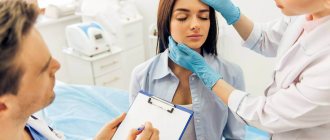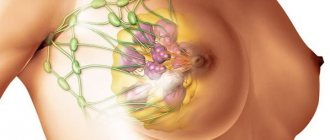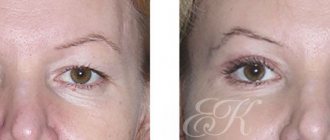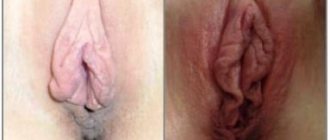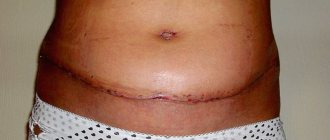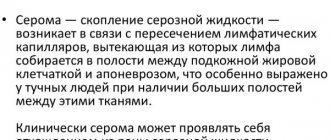METHODS OF BREAST RESTORATION
Breast reshaping can be done immediately after removal. Most often, this method is used after subcutaneous mastectomy. Due to the small size of the tumor and its location far enough from the nipple, the surgeon is able to save the skin flap along with the alveolus. Simultaneous reconstruction is also possible with radical mastectomy. If a woman is not yet mentally or for health reasons ready for additional surgical intervention, then it should be delayed until the scarring is complete. One-step recovery is considered less traumatic, but is not suitable for everyone. Consultation with an oncologist is required.
The choice of method depends on the volume of tissue removed. If enough skin and muscle have been preserved, saline or silicone implants can be used. Otherwise, the mammary gland is formed by autotransplantation. A flap consisting of a section of muscle, fat layer, blood vessels, and skin is used. It is taken from the buttocks, back, and abdomen.
Risks and complications
Risks and complications that a patient may experience during breast reconstruction include:
- bleeding or bruising
- inflammation
- possible complications during anesthesia
- fluid accumulation in the breast or donor site (for skin flap surgery)
- fatigue
- long-term wound healing
Additional complications that may occur after surgery include:
- necrosis, which may develop in the skin, fatty tissue, or tissue flap
- loss of muscle strength at the donor site (for skin flap surgery)
- changes in breast or nipple sensation
- the need for additional surgical interventions if complications occur
- uneven breasts
- problems with the implant, such as movement, rupture, leakage, or scar tissue formation
- need to remove implants
Additional procedures are sometimes required after the first stages of surgery. Minor revision surgeries are usually performed several months to several years after a mastectomy and implant or flap reconstruction, as well as after any additional treatments such as chemotherapy or radiation therapy.
Nipple reconstruction may be necessary. During this procedure, the surgeon stitches together small areas of skin on the reconstructed breast to create a nipple-like bump. The patient can then choose to have that nipple and the skin around it tattooed to create the appearance of an areola.
Some people choose not to have their nipple reconstructed and instead get a 3D nipple tattoo that uses shading to create the appearance of an elevated nipple.
Other revision surgeries may include fat grafting, in which the surgeon performs liposuction on the torso or thighs to obtain fat, which they then inject around the reconstructed breast to improve the appearance of the breasts.
The patient may require multiple fat grafting sessions.
These smaller surgeries require minimal recovery time.
PREPARATION FOR BREAST RECONSTRUCTION OPERATION
Reconstruction is a much more complex operation compared to restoring sagging breasts. The surgeon will provide detailed instructions regarding preparation. During the appointment, he will prescribe the necessary examinations. In particular, it is necessary to donate blood, undergo an ECG, and x-ray. You will have to avoid taking nonsteroidal anti-inflammatory drugs, aspirin, and vitamin E. A laxative may be prescribed before the procedure (anesthesia often causes constipation). Smoking is completely excluded - nicotine impairs tissue healing, can lead to necrosis or provoke complications when using anesthesia.
BREAST RESTORATION USING IMPLANTS
Breast reconstruction surgery with implants is considered an unsuitable option for women with very large busts. To fully match the shape and size, surgery on the second breast may be required (depending on the situation, the surgeon will reduce its size or use an implant). An integrated approach will eliminate the natural age-related changes in the healthy mammary gland and the resulting imbalance.
How is the recovery operation performed? The implant is installed in an “envelope” consisting of a skin flap and muscles. An expander (an expander with a sterile physical solution) is used for formation. After its installation, the doctor gradually adds liquid during appointments, thereby stretching the “pocket”. After the formation of the bed (the process takes 4-6 months), the expander (retractor) is replaced with an implant.
A permanent (two-chamber) expander can be used - one of the chambers contains silicone gel, and the second - saline solution, which is subsequently completely removed. The bust gains elasticity due to the silicone chamber.
The main risks after breast reconstruction with implants are: violation of the integrity of the membrane, extrusion (break through the skin), suppuration. This can be avoided by strictly following the doctor’s recommendations. After installing the implant, it is not advisable to undergo radiation therapy - there is a high risk of damage to it. If silicone is used as a filler, periodic MRI scanning is recommended (gel leakage cannot be visually determined).
The main disadvantage of this method: over time, a repeat procedure will be required. Pros: scars after surgery are almost invisible, healing takes only 2-3 weeks.
When is it possible
Many women (especially young ones) think about breast reconstruction even before breast removal or immediately after. But the question of when restoration can be carried out cannot be answered unambiguously. Much depends on the stage of the disease and the type of tumor associated with the risk of relapse, as well as on whether the patient has had radiation and/or chemotherapy or is just about to undergo it. Therefore, this question should only be addressed to your doctor. You cannot begin plastic surgery until postoperative treatment has been completed in full.
From stress to obesity. Doctor about factors influencing the development of breast cancer Read more
In addition, there are contraindications, both absolute, which make such an operation impossible in principle, and relative (in this case, the intervention will have to be postponed until better times). Among the absolute contraindications:
- late stage or locally advanced breast cancer (from stage IIIb), as well as combined cancer;
- severe concomitant pathologies (including diabetes mellitus, poor blood clotting, dysfunction of the endocrine system);
- relapse of the disease.
Article on the topicWhere are the wizards? How to choose a plastic surgeon
Relative contraindications are:
- unfavorable molecular type of breast cancer (this is a conditional contraindication, it only indicates an increased risk of relapse);
- infectious diseases and any diseases in the acute stage;
- diseases of the mammary glands (including mastopathy);
- chronic purulent processes;
- minor age;
- pregnancy;
- pronounced radiation reaction of the skin after radiotherapy.
BREAST RECONSTRUCTION USING AUTOLOGIC TISSUE
An operation to restore the chest muscles can be performed using the patient’s tissue - a flap is taken from the back, abdomen, buttocks. In some cases, reconstruction is limited to using only the skin, fat layer, and blood vessels - the muscle is not affected, which reduces trauma.
Thoracodorsal technology involves the use of a flap from the back. Since the fat layer in this area is usually not very developed, an implant can be used to add volume.
How is the operation performed? The formed flap is transplanted to the site of the removed breast through a tunnel under the skin. Blood vessels are preserved to the maximum. The operation ends with the formation of the mammary gland and suturing. This method is suitable for women with small breasts. The muscular function of the back is not damaged, but the scar remains (slight disproportion of the back may appear).
If the bulk of adipose tissue is concentrated in the abdominal region, a flap is taken from the rectus abdominis muscle and then moved through a tunnel to the transplantation site. Additionally, an implant can be used during reconstruction. If a vessel has to be cut during surgery, it is sutured to the flap using microsurgical equipment. The TRAM Flap method is accompanied by abdominoplasty and reconstruction of the navel (displacement occurs when the material is taken).
The abdominal flap is transferred using the DIEP FLAP method. Unlike the previous reconstruction method, the material contains only skin, adipose tissue, and blood vessels. This reduces the trauma of the operation and avoids abdominal muscle weakness. Due to the need to suture all vessels, reconstruction and restoration of breast elasticity takes about five hours.
S-GAP and I-GAP are used if the bulk of adipose tissue is concentrated on the buttocks. A flap taken from the upper or lower part of the buttocks is used. Skin, fat, and blood vessels are transplanted, but the muscles are not affected. Since surgeons have to completely restore the vessels, the duration of the operation can reach 10-12 hours. To balance the proportions, liposuction of the second buttock is usually performed. The advantage of S-GAP and I-GAP reconstruction is the possibility of repeat surgery if the graft does not take root. When using other recovery methods, this is not possible.
Complications of the operation include pain and the formation of a rough scar at the site where the material was taken. If the surgeon is insufficiently qualified, tissue rejection (necrosis) is possible. That is why it is so important to contact a trustworthy medical institution. The clinic has professional technical equipment. There are comfortable rooms with 24-hour medical care.
Skin flap surgery
An autologous transplant moves tissue from another part of the body onto the chest to reconstruct the breast.
More often the flap is used from the abdominal wall or back.
Skin flap surgery is very complex as it involves moving tissue from one area of the body to another. There are two methods available for this operation:
- Free flap transfer
- Pedicled flap surgery
Free flap surgery uses microsurgical techniques and a microscope.
In pedicled flap surgery, vascular connections to the donor site are maintained.
RESTORATION OF THE NIPPLE AND AREOLA OF THE BREAST
After breast removal, mammoplasty is the main task, which is undesirable to postpone for a long time (primarily due to the psychological discomfort that the woman experiences). Restoration of the nipple and areola is a secondary procedure. Often women refuse to undergo it, being completely satisfied with the result obtained. If the patient still wishes to undergo correction, she will have to wait for complete tissue healing and completion of adjuvant therapy. An exception is TRAM reconstruction, during which the entire range of work can be carried out at once.
The simplest method of restoring the areola of the breast is a 3D tattoo. The pigment is selected in accordance with the natural tone of the second nipple. With the help of a tattoo it is possible to disguise scars. The main disadvantage is that this method does not recreate the nipple itself. More complex methods involve the use of the patient's own tissue. To create volume in the area of the future nipple, adipose (fat) tissue can be placed under the skin. Skin transplanted from the perineum can imitate an areola. The nipple is recreated from pieces of breast skin - the methods of its formation depend on the shape of the cut flap.
Price issue
Breast reconstruction can be carried out using funds from the Compulsory Medical Insurance Fund. However, in the last few years, compulsory health insurance has almost completely stopped paying for such operations. Today they are still done in some oncology clinics, but only 1-2 per month, since their implementation is unprofitable for both the hospital and the compulsory medical insurance. In addition, such a reconstruction has too many disadvantages. For reasons of economy, implants and expanders are used only from the cheapest manufacturers and often only in one size. Therefore, patients interested in a good aesthetic result often have to pay outright for reconstructive operations in government institutions.
Today it is possible to reconstruct the breast using high-tech medical care (high-tech medical care) in large oncology centers. In this case, the materials used are more modern and of high quality, but it is not always easy for patients to obtain a quota for such treatment. Sometimes this journey can take months. In addition, in hospitals that admit patients under quotas, there is also a waiting list.
Finally, you can undergo breast reconstruction at your own expense. Such an operation can cost from 70 thousand rubles for, for example, delayed installation of an expander on one side, to 500–700 thousand rubles for complex combined operations using bioflaps, own tissues with suturing of blood vessels under a microscope, as well as correction of a healthy breast.
REHABILITATION AFTER BREAST RECONSTRUCTION SURGERY
The first days after reconstruction will have to be spent in a hospital under the supervision of doctors - our clinic offers patients 14 comfortable rooms. The stitches will be removed in two weeks. For about six months after breast reconstruction, you need to wear a special bra or bandage. If drainage has been installed, you will have to take care of the system and measure the amount of fluid released. Since painful sensations are observed at first, the doctor may prescribe painkillers.
After the procedure, you should avoid heavy lifting, physical activity, and intimate contact for 4-6 weeks. It is advisable to delegate most of the household chores to your loved ones. Swelling and hematomas will persist for about 8 weeks after reconstruction, so it will not be possible to immediately assess the aesthetic result of the operation. Visiting a bathhouse, sauna, swimming pool, or hot countries is excluded (this opportunity will appear 3 months after the operation or later). At the frequency prescribed by the doctor, the woman will need to undergo follow-up examinations, as well as mammographic examinations.
Clothing during the recovery period should be comfortable - not squeezing the mammary glands and the site where the flap is taken. It is advisable that the blouse or blouse have a fastener (buttons, zipper). The doctor usually recommends breast reconstruction with massages in case of implant installation. If autologous tissue was used in the reconstruction, then physiotherapeutic methods are prescribed to overcome the muscle weakness of the donor site.
This is not dangerous
Many women worry that future breast reconstruction may make screening more difficult. But for this purpose, neither a flap of one’s own tissue nor an implant interferes, especially since CT or MRI, rather than mammography, is often used to control the disease. But with one condition: all studies must be carried out by qualified specialists in a specialized oncological institution; it is better to do them in the same place and with one specialist, so that it is possible to compare the picture over time. It is also important to observe the required frequency of research (every six months, a year, two, three and beyond).
Article on the topic
Corporate conspiracy or personal decision? Expert on mastectomy, Jolie and cancer
COST OF BREAST RECONSTRUCTION
Since breast reconstruction surgery is performed for aesthetic purposes and not to restore health, it is performed at the patient's expense. The state health insurance program does not cover such plastic surgeries. The price for breast reconstruction depends on the complexity of the case, the method used, and the number of days spent in the hospital. It also includes examinations, consultations with an anesthesiologist and other doctors, anesthesia, and postoperative support.
Features of breast reconstructive surgery
An essential feature of reconstructive mammoplasty is the fact that this operation belongs to the category of not only reconstructive, but also aesthetic. The goal can be achieved by solving the following tasks:
- restoration of breast volume
- creating an aesthetic form
- skin restoration
- restoration of the nipple-areolar complex
- restoration of symmetry; restoration of normal consistency.
CASES FOR BREAST RECONSTRUCTION
Breast reconstruction surgery solves aesthetic and physiological problems. The absence of breasts leads to a change in the load on the spine - over time, this provokes deterioration of posture, drooping of the shoulders and other secondary changes in the osteoarticular system. Due to the curvature of the spine, the functioning of the lungs and heart is disrupted.
To use services for breast reconstruction after mastectomy, make an appointment on the website, call the reception (+7 (8617) 309-001) or request a call back.
Author of the article
Plastic surgeon
Astashkin Pavel Vyacheslavovich
Rehabilitation
The doctor may recommend this operation if he sees that the patient is seriously suffering psychologically from the defect, and there is a risk of mental disorders. After a mastectomy, a woman may develop various complexes. It seems to her that everyone is paying attention to her defect. They are embarrassed to go to the beach, pool, or bathhouse. Sexual relationships with a partner change especially significantly. In such cases, to eliminate psychological stress, surgery is recommended in the absence of contraindications.
Postoperative recovery lasts from 7 to 15 days, depending on the complexity of the operation. All this time the patient has been in the hospital. During the operation, drainage tubes are installed, which are removed after 5-7 days. The sutures are removed after 12-15 days or dissolve on their own using special threads.
Further recovery is provided outside the hospital for 1 -1.5 months. During this period, it is necessary to wear compression garments. For 2 weeks you can only lie on your back. Only after this period can you roll over on your side. You can lie on your stomach after 30 days and after examination by a doctor.
Significant physical activity, overheating, and visiting bathhouses and swimming pools are prohibited for 2-3 months. You can't play sports. All traces of stitches and scars disappear after 1.5-2 years. During the entire recovery period, the patient must be under medical supervision. After reconstruction, the following temporary side effects are possible: pain and discomfort, decreased sensitivity in areas adjacent to the breast, swelling and temporary asymmetry of the breast due to them.
Our portfolio
Go to the full list of paid services for plastic surgery

